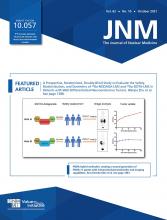TO THE EDITOR: Without any doubt, the breakthrough in radiopharmaceuticals targeting prostate-specific membrane antigen (PSMA) has stirred up nuclear medicine and radiopharmaceutical research and ultimately boosted industrial engagement in the entire field. The first-in-humans application of the 68Ga-labeled PET tracer 68Ga-PSMA-11 in 2011 (hence its present name; initially referred to as 68Ga-HBED-PSMA) (1) galvanized the community and led to a fierce race toward the matching 177Lu-therapeutics. To the best of our knowledge, this games’ first goal was scored by 177Lu-PSMA I&T, being the first radiometal-based PSMA ligand that was successfully applied for therapy of metastatic castration-resistant prostate carcinoma (2). Shortly thereafter, one novel compound after another appeared, aiming primarily at therapeutic applications (e.g., 177Lu-PSMA-617) (3) and purely imaging applications (e.g., 18F-PSMA-1001) (4). Interestingly, the commercial interest also led to unexpected short squeezes in some supply chains. For example, PSMA-617 became widely unavailable one fine day as a result of a change in ownership of the patent rights, leaving many clinical radiopharmacies at odds on how to settle their respective requirements.
At this point, it is interesting to note that no patents were filed for PSMA-11 and PSMA I&T, most likely because the tremendous commercial success of this class of radiopharmaceuticals was not foreseeable at that time. As a result, PSMA-11 was widely used and became a global de facto standard for PSMA PET in an incredibly short time. Because it is sold by numerous manufacturers worldwide and is available as a labeling kit, it is still one of the most frequently used PSMA tracers, despite other agents that might arguably be more potent. In principle, the same used to be true for PSMA I&T. For quite a time, many departments were relying on it for their clinical routine. However, the market situation for this compound also took an interesting turn when a fairly old chelator patent entered the stage.
PSMA I&T features a particular flavor of DOTA as the chelator moiety (5), namely, a tetraazacyclododecane with 3 acetic acids and 1 glutaric acid side arm—hence its acronym DOTAGA (6). This bifunctional chelator structure was developed more than 20 y ago by Helmut Mäcke et al., and a patent application was filed for it on May 11, 2001 (7). The patent slumbered for quite a while but eventually was licensed from Basel University by CheMatech, a company that codeveloped and marketed DOTAGA anhydride (8), a valuable building block for making DOTAGA-functionalized compounds. By February 2019, parts of the same patent, covering the use of DOTAGA in all its conjugates, allegedly were sublicensed to another player in the field in order to gain property rights for PSMA I&T (9). As a countermove, others have announced that any applicable license fees for PSMA I&T, made from a stock of DOTAGA anhydride purchased from CheMatech before February 2019, have inherently been settled by originally purchasing the DOTAGA used for making PSMA I&T from a licensee (i.e., CheMatech), and thus, the PSMA I&T produced therewith may nonetheless be purchased and used without infringing any law (10).
Whether this is true shall not be commented on here, since this legal skirmish just became history anyway. It remains to be asked to what extent the expiry of the DOTAGA patent (by May 11, 2021) bears the potential to change the game of thrones that is being played in the field of PSMA theranostics. The fact that a powerful therapeutic PSMA radioligand, 177Lu-PSMA I&T, may be manufactured and used without any patent restrictions from May 11 onward will probably have an impact on future development, availability, and pricing of similar agents. To all researchers in the field, this tale might be a lesson—and a warning—to secure their intellectual property in sufficient time to save themselves from late regrets.
Footnotes
Published online March 31, 2021.
- © 2021 by the Society of Nuclear Medicine and Molecular Imaging.
REFERENCES
- Revision received March 13, 2021.
- Accepted for publication March 16, 2021.







